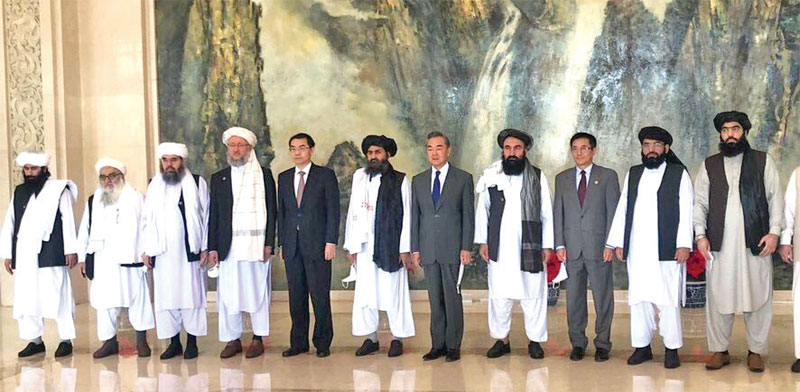Internal and external churning in the neighbourhood may pose problems for India’s security
 Col Ajay Singh (retd)
Col Ajay Singh (retd)
The past year has been one of considerable churn in the neighbourhood. Tensions on the India-China border have continued with China hardening its stance and showing no indications of pulling back.
With the Taliban back in Kabul, the chaos of the US withdrawal from Afghanistan has upended 20 years of assiduous diplomatic gains. And of course, in spite of occasionally positive voices emerging from Pakistan, relations are frosty to say the least. All this, with other nations in the region—Sri Lanka, Nepal, the Maldives—facing their own internal turmoil and a military coup in Myanmar.
India has navigated the churn quite adroitly so far, but some of the happenings may impinge on our security in the coming year or so. Let us have a quick look at some regional events and their likely impact upon us.
The Af-Pak Region
Perhaps the greatest geopolitical churn has been caused by the US withdrawal from Afghanistan last August. The fall of the Ghani government and the return of a potentially hostile regime back in Kabul, threaten our interests and buttress Pakistan’s claims for so called ‘strategic depth.’
Although the Taliban have gone back to doing what they do best—curbing travel and education for women, lopping heads of mannequins, forcing men to don beards and heralding a return to the Islamic Emirate—their recent pronouncements show a sort of outreach towards India. India has kept its options open by establishing communication channels with the Taliban and providing much needed aid and vaccines to the beleaguered nation.
With the cessation of foreign aid (which accounts for a whopping 45 per cent of its GDP) and the blocking of USD 9 billion of Afghan funds in US banks, most government employees have not been paid and over 23 per cent of the population faces starvation in the winter. The Taliban are discovering that running a nation is a far cry from taking it over, and Afghanistan could be headed for greater turmoil—perhaps even a civil war. This summer will see the instability of Afghanistan come to the fore which could spill across the region and onto our soil.
Pakistan has heralded its success in Afghanistan as a vindication of its policies, but it may be a double-edged victory. They too are going through their own churn. The GDP has dropped to USD 280 billion (below the USD350 of Bangladesh and India’s USD 3.1 trillion) and their debt to GDP ratio is an astounding 87 per cent. The IMF has released an aid tranche of USD 1 billion which could provide immediate relief, but the conditionalities will impose hardships on people, already reeling under price rise, scarcities, and inflation. All this is compounded by political instability. Imran Khan’s government is under siege by the hardline Islamist party, the Tehreek-e-Labbaik, which forced it to capitulate for the release of its cadres. Army–government relations too have come to a head over the appointment of the new ISI Chief and many political pundits predict that this government is unlikely to last out its full term.
Also, the return of the Taliban has created unforeseen problems for them. Emboldened by the success of the Taliban, the Tehreek-e-Taliban Pakistan have ramped up activities, rejecting a ceasefire and launching over 45 strikes inside Pakistan in November—December alone. The new Taliban government has also taken up a strong position on the 2670 km long Durand Line (which they do not recognize) and have even dismantled sections of the border fence along it. There could be a resurgence of Pushtoonism in Waziristan and Islamic fundamentalism may once again rear its head in the hinterland.
It is perhaps due to the realization of the looming threats that Islamabad has shown some measure of mellowness towards India. The ceasefire along the LOC has held all year, which is a good harbinger. Their Army Chief has talked of “burying the past and moving ahead economically.” Their recently unveiled New Security Policy talks of 100 years of peace with India and resumption of trade and economic ties. But at the same time, it puts the settlement of the Kashmir issue as a ‘core security interest.’ How far will they go ahead with this new doctrine, and whether the Generals will permit peace and détente remains to be seen. After all, even now, over 400 terrorists are waiting to be funnelled into Kashmir from launchpads inside POK. But should some measure of rapprochement be attained, it could usher in an era of mutual peace and prosperity.

The Dragon in the Room
While Pakistan is sending out the right signals, the major challenge comes from China, which remains as inscrutable as always. The 21-month long border stand-off continues unabated, with both sides amassing over 50,000 troops, Air Defence guns, tanks and artillery along the LAC. 13 rounds of talks have resulted in a small measure of disengagement—especially near PP 14 at Galwan, along the North and South banks of Pangong Tso, and at Gogra Post. But Chinese presence still remains in the contentious Hot Springs, Depsang and Demchok areas.
Chinese intransigence to withdraw to its pre-May positions have been compounded by the development of infrastructure in these areas, perhaps to buttress their claims. This includes the construction of a 400-meter-long bridge across the Pangong Tso which will reduce travel time to its posts from 12 hours to just around four. They have also upgraded the G 219 and the G 318 national highways running along the Ladakh and Arunachal Pradesh borders and created helipads, airstrips and billets. A new Land Border Law makes the boundaries ‘sacred and inviolable’ and encourages the development of dual use infrastructure in the border regions. 628 model villages have come up there. Chinese actions like the renaming of areas inside Arunachal Pradesh in the garb of ‘standardisation’ are all indicators of a hardening stance and it is unlikely that they will relinquish their claims now.
Yet, China too faces its own internal issues. Omicron and an insistence on a complete lockdown have taken a toll. Its economy has slowed down to a growth rate of 4.2 per cent and is expected to fall further, largely due to Xi’s crackdown on big business. Xi would want to show some major achievement before the CCCP plenary meet in 2022 to decide his third term. Perhaps Ladakh and Arunachal are the targets he eyes to test the waters, before moving to more ambitious targets of Taiwan and the South Sea.
But China seems to have overplayed its hand. The global push back has gathered traction, especially with Biden’s focus on the Indo-Pacific. A slew of alliances such as Quad (which will hold its next Summit in Tokyo this June), AUKUS and also bilateral ones between USA and Japan, the Reciprocal Access Agreement between Japan and Australia, and India’s own ties with USA, Japan and Australia are indicators that the region is closing ranks to counter the Chinese threat. Yet, India should not be under any illusion of what these pacts entail. Should there be a conflict or even a localized skirmish between India and China, barring expressions of support, some shipments of highly priced arms, and maybe some intelligence inputs or so, no other form of support will be forthcoming. India should be prepared to tackle the situation alone.
What adds another dimension is the still robust economic ties between India and China. Bilateral trade grew a whopping 43.3 per cent in 2021, with a record high in both exports (USD28.1 billion, up 28 per cent since 2020) and imports (USD97.5 billion, up 46.1 per cent from 2020). Though the trade deficit is heavily skewed in favour of China, the very fact that trade continues is a healthy sign and can be leveraged to help resolve the border issue.
Other Nations of the Neighbourhood
Other nations in the region have also been hit by Covid and geopolitical developments. Sri Lanka, which had embraced Chinese investments with open arms, has been virtually driven to bankruptcy with just USD 1.6 billion of foreign reserves to tide it through for a few weeks or so. Plus, it has a debt obligation of USD 7 Billion (with USD 3.38 billion to China alone).
Although India has provided a USD500 million tranche of aid, it will barely keep it afloat. The extent of China’s predatory financing has resulted in the loss Hambantota port, bringing China dangerously close to our own shores. But the pro-China leanings of the Rajapaksa brothers ensures that Chinese influence remains deep rooted, perhaps at our expense.
Myanmar is another neighbour in a state of flux. Ever since the military coup of February 2021, the hermit kingdom has been racked by civil protests which has claimed over 10,000 lives and created over a million refugees. The military takeover has put our own diplomacy at test. While condemning it, we should not let it affect the traditionally good ties we have with the Tatmadaw. Perhaps, we can use our influence for a gradual return to democracy and even keep China from fishing in troubled waters.
With Nepal, ties are slowly back in the reset mode after the lows of the boundary issue of Lipulekh and Kalapani. But traditional pacts and treaties need to be seriously reviewed to ensure that ties remain on a sound footing. In the Maldives, the elevation of President Ibrahim Solih will help mend ties which had been seriously frayed during the tenure of President Abdullah Yameen. In both cases, we have to compete with China’s cheque book diplomacy. The danger of Chinese financing is slowly emerging, and we can help provide safer alternatives.
The silver lining is Bangladesh which is fast emerging as the success story of South Asia, having, under Sheikh Hasina, made impressive economic gains and also kept Islamic fundamentalism at bay. As India and Bangladesh celebrate the 50th Anniversary of its birth, perhaps we can seize the symbolism of the moment to put ties on an even higher trajectory.
Most of the nations in the region face their own internal and external churn—in many cases acerbated by the third wave of Covid. India too faces the churn, largely through the actions of China and Pakistan, which could reach some kind of flashpoint in this year. Their actions will continue to threaten Indian interests, and as China encroaches deeper in the neighbourhood, the independent equations we have with regional players will help counter it. These relationships will eventually shape our own stature and destiny as a regional power.
(The writer is the author of five books and recipient of Rabindranath Tagore International Award for Art and Literature 2021)

